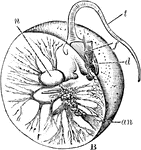Clipart tagged: ‘dinoflagellates’

Noctilucales
An illustration of Noticulales with buds. The Noctilucales are a peculiar order of marine dinoflagellates.…

Noctilucales
An illustration of Noticulales in section: an, anus; d, denticle; f, flagellum; t, tentacle. The Noctilucales…

Noctilucales
The Noctilucales are a peculiar order of marine dinoflagellates. They differ from most others in that…